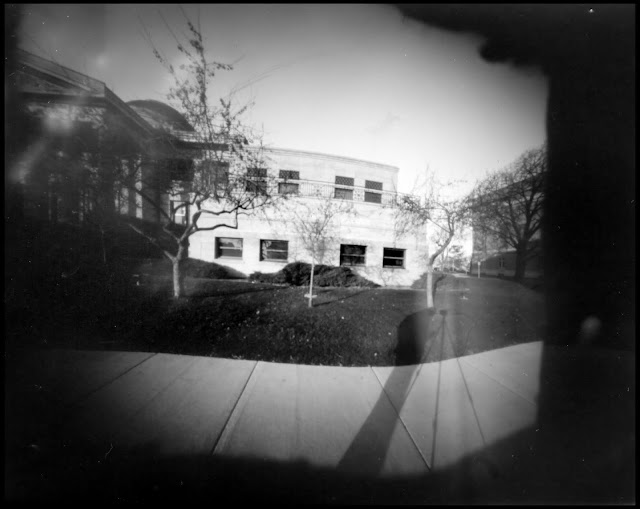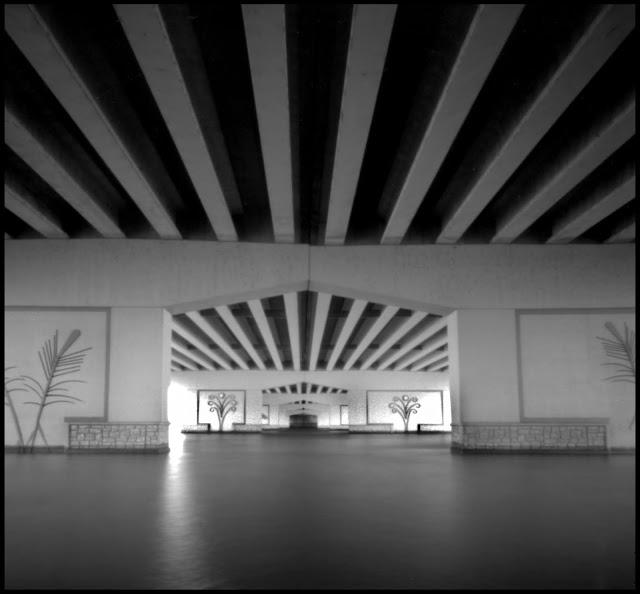When I was having trouble with the widest setting on the 4x5 Pinhole Lab Camera, I said I wasn’t too perturbed because I didn’t particularly like the most extreme wide angles of view. Whenever I hear myself say something like that, I end up worrying that it’s because I haven’t really given it a proper try. I decided I should see if I could experience the charm of the ultra wide angle. It did not go well.
I had intended the widest option on the Pinhole Lab Camera to be 36mm but I messed up when cutting and glueing the guides which make up the slots the film plane slides into. The last one had to be trimmed a little to fit. The image plane in that slot ended up being only 30mm away from the pinhole.
Also, when I glued the shutter on the outside, I didn’t quite get it positioned so the pinholes were exactly in the center of the opening. One side of the shutter blocked part of the image. I pried it off and reglued it more carefully so the pinhole was in the center, but that doesn’t seemed to have solved anything.
In my youth, my favorite lens was my Canon FD 20mm f2.8, so I have some idea of what was then considered ultra-wide angle. This thing would be equivalent to a 9mm lens on a 35mm camera.
At 30mm on a 4x5 (100 x125mm) negative, Mr. Pinhole says the image circle is only 2.25 inches (60mm). That’s some pretty extreme vignetting especially when using black and white photographic paper which can be very high contrast. Another thing I forgot about was the spectral response of the paper. Mickey and Minnie’s red car, under a spotlight, wasn’t the best choice to try things out.

A difficulty with extreme wide angle is that it’s almost impossible to previsualize what you’re photographing. The angle of view at this distance to the pinhole is 129 degrees. The human field of view is actually wider than that, but 129 degrees is wider than your brain can frame into a picture. I thought I was looking straight at Mickey and Minnie in the car, but from the point of view of the pinhole, it’s only looking straight at the center. It’s looking significantly up at the top of the frame and down at the bottom. The extreme relative changes in size with distance is also hard to conceptualize. The hood ornament on top the grill is quite small, but is big enough in the image to completely obscure Mickey.
I tried a red pear, an apple and a lemon in a sunbeam on the kitchen table. Not another great choice.
I tried a much lower contrast subject. Now I can see that the shutter was still blocking part of the image on the bottom, but again, it faded to black before I could tell if the sides were unobstucted.
What I needed was a scene that was dark in the center and bright on the outsides. I took the fruit out on the porch, and that worked a little better with the vignetting and now I could definitely see the shutter was still a problem. However, I think I see a glimpse of the attraction of the extreme wide angle with this one.
I went outside to see if I could learn anything from a more uniformly illuminated subject. A wide angle is handy when you can’t get very far away from your subject. I could get the entire entrance of the First National Bank building while still on the narrow side walk, but the vignetting kind of defeats the purpose. This one is also with the rising front.
Even if you could overcome the vignetting, it’s really a struggle to get close enough to things to fill the frame. I was going for the novelty effect here. It’s not as crazy as I thought it would be. The camera in this case is about an inch from my nose and the tips of my fingers are actually under the camera.
If the shutter is blocking that much of the frame, I can’t really get interested in experimenting further. So what can I do about this?
I could make the opening for the shutter bigger. Remember, however, that I made this camera not specifically for wide angle, but to work with 4x5 negatives at a variety of angles of view, and it’s fine at the 3, 4.5 and 6 inch distances.
Another option is to back off to a less extreme angle. That would make the shutter blockage less of a problem and the vignetting would be less extreme so maybe I could make use of the entire frame. I pried off that front guide I had trimmed to fit and the second one and switched their order. Now the widest angle slot is at 38mm, still pretty darn wide on a 4x5 negative. I also trimmed a little off the shutter holes.
One good thing I learned was that the 28 year old paper I had left from my 1992 grant was still workable as a negative. The last three images were done with it. There’s a little background fogging, but that may help to control contrast, kind of like very slow pre-flashing.





























































